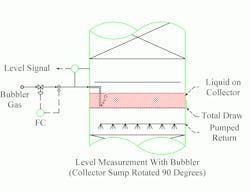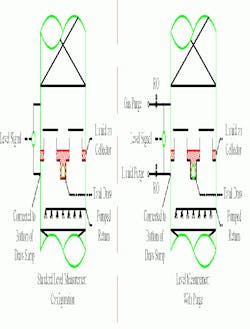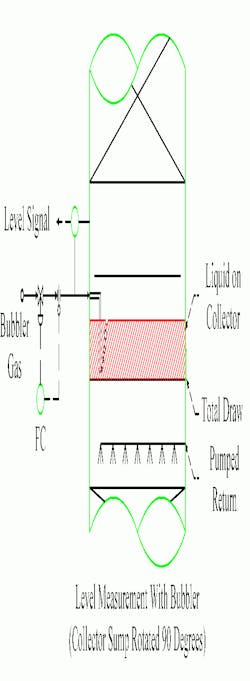Bubbles can buoy level measurement
Operating conditions sometimes impose reliability and maintenance requirements that force you into selecting specific equipment. One prime example is level measurement in high temperature, high fouling services. While non-contact devices often are the best choices to cope with fouling, high temperatures may make typical radar or ultrasonic units impossible to use. Other non-contact measurement techniques, such as gamma ray and neutron backscatter, may cost too much for your budget. However, there’re a couple of less-expensive options: purged differential pressure (DP) cells and bubblers.
A standard level-measurement system uses a DP cell attached to the vessel at two points: one in the vapor space above the liquid and the second in the liquid at its lower level position; Figure 1 shows this connection to a collector tray in a distillation tower. The usefulness of the level signal depends upon the accuracy, precision and reliability of the cell. If the liquid is prone to plugging, then the impulse lines from the DP cell to the vessel may clog, causing inaccurate readings.
Adding purges to either or both taps (Figure 1), as required, can keep the lines clean. Typical installations use restriction orifices (RO) in the purge lines to prevent excessive flows. Even so, the pressure drop from the purge connection point to the vessel can cause incorrect level readings —falsely high if the pressure drop is on the liquid side and falsely low if the pressure drop is on the gas side.
Figure 1. Addition of gas and liquid purges to a standard level-measurement configuration can prevent clogging. (Click to enlarge)
Finding purge fluids compatible with the process and equipment may pose challenges. Nitrogen gas is frequently available and may be suitable if it can be removed later. The liquid stream tends to be more difficult. Often the only compatible one is the actual process liquid itself. As long as existing pumped streams can be used, this may be feasible. However, incompatible liquids, density differences caused by cooled purge streams, and flashing liquids all can create major problems.
If you’re okay with adding gas to the process, you do have another choice — a bubbler installation (Figure 2). A controlled gas stream is injected into a tube that descends into the process liquid. The flow rate and differential pressure between the gas and the vessel provide an indication of liquid level.
Figure 2. A bubbler may work better than a purged DP cell and won’t use any more gas. (Click to enlarge)
Bubbler systems require accurate pressure measurement and flow control and a constant composition gas stream. They have more sources of error than a straightforward DP cell but may work better than a purged DP cell.
Many instrumentation engineers avoid bubblers in fouling services because the gas rate required to keep the bubbler from fouling is high. However, you should compare the bubbler gas requirement to the purged DP cell instead of to a standard DP cell.
There’s no difference between the gas rate required to keep a purged connection clear and that needed to keep a bubbler operating. Bubblers have been used in extremely fouling services with great success. Just keep the vapor rate high enough to keep them clean.
While installation is more expensive than for a conventional DP cell, the cost is much lower than buying a nuclear device for high-temperature liquid services. Additionally, you avoid the increasing regulatory burden of keeping track of nuclear sources. Of course, some applications definitely demand gamma ray or neutron backscatter but most level measurements can get by with other means. Consider the bubbler when process choices allow it.
Andrew Sloley, contributing editor
[email protected]


